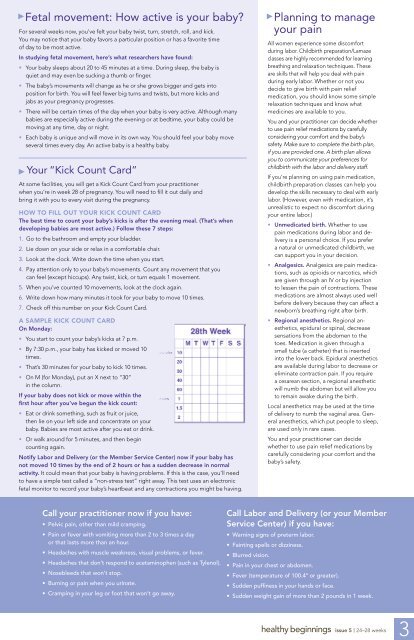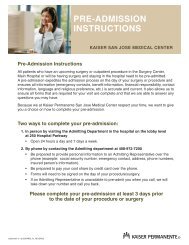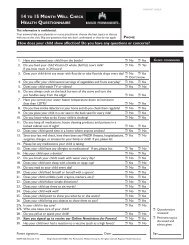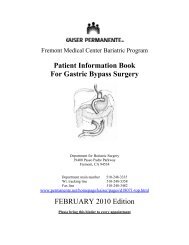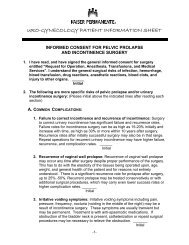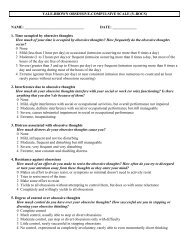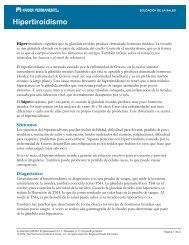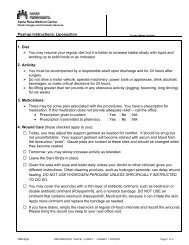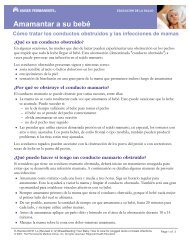24 to 28 weeks (PDF) - Kaiser Permanente
24 to 28 weeks (PDF) - Kaiser Permanente
24 to 28 weeks (PDF) - Kaiser Permanente
You also want an ePaper? Increase the reach of your titles
YUMPU automatically turns print PDFs into web optimized ePapers that Google loves.
▲<br />
Fetal movement: How active is your baby?<br />
For several <strong>weeks</strong> now, you’ve felt your baby twist, turn, stretch, roll, and kick.<br />
You may notice that your baby favors a particular position or has a favorite time<br />
of day <strong>to</strong> be most active.<br />
In studying fetal movement, here’s what researchers have found:<br />
• Your baby sleeps about 20 <strong>to</strong> 45 minutes at a time. During sleep, the baby is<br />
quiet and may even be sucking a thumb or finger.<br />
• The baby’s movements will change as he or she grows bigger and gets in<strong>to</strong><br />
position for birth. You will feel fewer big turns and twists, but more kicks and<br />
jabs as your pregnancy progresses.<br />
• There will be certain times of the day when your baby is very active. Although many<br />
babies are especially active during the evening or at bedtime, your baby could be<br />
moving at any time, day or night.<br />
• Each baby is unique and will move in its own way. You should feel your baby move<br />
several times every day. An active baby is a healthy baby.<br />
▲<br />
Your “Kick Count Card”<br />
At some facilities, you will get a Kick Count Card from your practitioner<br />
when you’re in week <strong>28</strong> of pregnancy. You will need <strong>to</strong> fill it out daily and<br />
bring it with you <strong>to</strong> every visit during the pregnancy.<br />
HOW TO FILL OUT YOUR KICK COUNT CARD<br />
The best time <strong>to</strong> count your baby’s kicks is after the evening meal. (That’s when<br />
developing babies are most active.) Follow these 7 steps:<br />
1. Go <strong>to</strong> the bathroom and empty your bladder.<br />
2. Lie down on your side or relax in a comfortable chair.<br />
3. Look at the clock. Write down the time when you start.<br />
4. Pay attention only <strong>to</strong> your baby’s movements. Count any movement that you<br />
can feel (except hiccups). Any twist, kick, or turn equals 1 movement.<br />
5. When you’ve counted 10 movements, look at the clock again.<br />
6. Write down how many minutes it <strong>to</strong>ok for your baby <strong>to</strong> move 10 times.<br />
7. Check off this number on your Kick Count Card.<br />
A SAMPLE KICK COUNT CARD<br />
On Monday:<br />
• You start <strong>to</strong> count your baby’s kicks at 7 p.m.<br />
• By 7:30 p.m., your baby has kicked or moved 10<br />
times.<br />
• That’s 30 minutes for your baby <strong>to</strong> kick 10 times.<br />
• On M (for Monday), put an X next <strong>to</strong> “30”<br />
in the column.<br />
If your baby does not kick or move within the<br />
first hour after you’ve begun the kick count:<br />
• Eat or drink something, such as fruit or juice,<br />
then lie on your left side and concentrate on your<br />
baby. Babies are most active after you eat or drink.<br />
• Or walk around for 5 minutes, and then begin<br />
counting again.<br />
Notify Labor and Delivery (or the Member Service Center) now if your baby has<br />
not moved 10 times by the end of 2 hours or has a sudden decrease in normal<br />
activity. It could mean that your baby is having problems. If this is the case, you’ll need<br />
<strong>to</strong> have a simple test called a “non-stress test” right away. This test uses an electronic<br />
fetal moni<strong>to</strong>r <strong>to</strong> record your baby’s heartbeat and any contractions you might be having.<br />
▲<br />
Planning <strong>to</strong> manage<br />
your pain<br />
All women experience some discomfort<br />
during labor. Childbirth preparation/Lamaze<br />
classes are highly recommended for learning<br />
breathing and relaxation techniques. These<br />
are skills that will help you deal with pain<br />
during early labor. Whether or not you<br />
decide <strong>to</strong> give birth with pain relief<br />
medication, you should know some simple<br />
relaxation techniques and know what<br />
medicines are available <strong>to</strong> you.<br />
You and your practitioner can decide whether<br />
<strong>to</strong> use pain relief medications by carefully<br />
considering your comfort and the baby’s<br />
safety. Make sure <strong>to</strong> complete the birth plan,<br />
if you are provided one. A birth plan allows<br />
you <strong>to</strong> communicate your preferences for<br />
childbirth with the labor and delivery staff.<br />
If you’re planning on using pain medication,<br />
childbirth preparation classes can help you<br />
develop the skills necessary <strong>to</strong> deal with early<br />
labor. (However, even with medication, it’s<br />
unrealistic <strong>to</strong> expect no discomfort during<br />
your entire labor.)<br />
• Unmedicated birth. Whether <strong>to</strong> use<br />
pain medications during labor and delivery<br />
is a personal choice. If you prefer<br />
a natural or unmedicated childbirth, we<br />
can support you in your decision.<br />
• Analgesics. Analgesics are pain medications,<br />
such as opioids or narcotics, which<br />
are given through an IV or by injection<br />
<strong>to</strong> lessen the pain of contractions. These<br />
medications are almost always used well<br />
before delivery because they can affect a<br />
newborn’s breathing right after birth.<br />
• Regional anesthetics. Regional anesthetics,<br />
epidural or spinal, decrease<br />
sensations from the abdomen <strong>to</strong> the<br />
<strong>to</strong>es. Medication is given through a<br />
small tube (a catheter) that is inserted<br />
in<strong>to</strong> the lower back. Epidural anesthetics<br />
are available during labor <strong>to</strong> decrease or<br />
eliminate contraction pain. If you require<br />
a cesarean section, a regional anesthetic<br />
will numb the abdomen but will allow you<br />
<strong>to</strong> remain awake during the birth.<br />
Local anesthetics may be used at the time<br />
of delivery <strong>to</strong> numb the vaginal area. General<br />
anesthetics, which put people <strong>to</strong> sleep,<br />
are used only in rare cases.<br />
You and your practitioner can decide<br />
whether <strong>to</strong> use pain relief medications by<br />
carefully considering your comfort and the<br />
baby’s safety.<br />
Call your practitioner now if you have:<br />
• Pelvic pain, other than mild cramping.<br />
• Pain or fever with vomiting more than 2 <strong>to</strong> 3 times a day<br />
or that lasts more than an hour.<br />
• Headaches with muscle weakness, visual problems, or fever.<br />
• Headaches that don’t respond <strong>to</strong> acetaminophen (such as Tylenol).<br />
• Nosebleeds that won’t s<strong>to</strong>p.<br />
• Burning or pain when you urinate.<br />
• Cramping in your leg or foot that won’t go away.<br />
Call Labor and Delivery (or your Member<br />
Service Center) if you have:<br />
• Warning signs of preterm labor.<br />
• Fainting spells or dizziness.<br />
• Blurred vision.<br />
• Pain in your chest or abdomen.<br />
• Fever (temperature of 100.4° or greater).<br />
• Sudden puffiness in your hands or face.<br />
• Sudden weight gain of more than 2 pounds in 1 week.<br />
healthy beginnings issue 5 | <strong>24</strong>–<strong>28</strong> <strong>weeks</strong><br />
3


